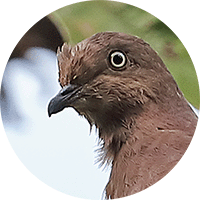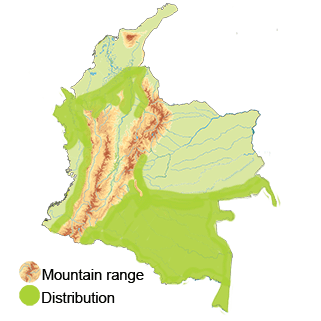Plumbeous Pigeon
The Plumbeous Pigeon (Patagioenas plumbea). Read in Spanish
Appearance: The Plumbeous Pigeon is a medium-sized pigeon with a primarily dark gray or bluish-gray plumage. It has a white lower belly and tips of the tail feathers. The bill is black, and the legs are reddish. The overall appearance is relatively plain and understated.
Habitat: Plumbeous Pigeons are typically found in a variety of forested habitats, including tropical and subtropical forests, as well as wooded areas near rivers, clearings, and agricultural land. They can be seen from lowlands up to around 2,000 meters in elevation.
Behavior: These pigeons are often seen foraging on the ground for seeds, fruits, and small invertebrates. They are generally shy and inconspicuous birds, preferring to stay hidden in the dense vegetation. Their flight is characterized by rapid wingbeats and strong, direct flight.
Breeding: Plumbeous Pigeons build relatively flimsy stick nests in trees or shrubs. The female typically lays one or two white eggs, which both parents take turns incubating for about two weeks. The young are altricial and are cared for by both parents until they fledge.
Conservation Status: The Plumbeous Pigeon is not considered globally threatened.
Distribution
The Plumbeous Pigeon (Patagioenas plumbea) is distributed across various regions of Colombia, typically inhabiting forested areas and wooded habitats.
- Andean Region: The Andean region of Colombia, which includes the mountainous areas along the Andes mountain range, provides suitable habitat for the Plumbeous Pigeon. They can be found in both the eastern and western slopes of the Andes, ranging from lower elevations up to around 2,000 meters.
- Amazon Region: Parts of Colombia, especially in the southeastern regions bordering the Amazon Rainforest, provide suitable habitat for the Plumbeous Pigeon. Forested areas with a dense canopy and abundant fruiting trees are ideal habitats for this species.
- Pacific Coast: Along the Pacific coast of Colombia, the Plumbeous Pigeon can be found in forested areas, including mangroves, tropical forests, and lowland woodlands. The presence of suitable roosting and foraging sites supports populations of Plumbeous Pigeons in this region.
- Orinoco Region: The Plumbeous Pigeon is also likely to occur in parts of the Orinoco River basin in eastern Colombia. Forested areas along the riverbanks and tributaries provide important habitats for this species.
- Caribbean Region: In the northern part of Colombia, including the Caribbean coast and the Sierra Nevada de Santa Marta mountain range, the Plumbeous Pigeon can be found in forested habitats at various elevations.
Taxonomy
The Plumbeous Pigeon (Patagioenas plumbea)
- Kingdom: Animalia
- Phylum: Chordata
- Class: Aves (Birds)
- Order: Columbiformes
- Family: Columbidae
- Genus: Patagioenas
- Species: Patagioenas plumbea
Vocalization
The Plumbeous Pigeon (Patagioenas plumbea)
- Cooing Calls: Like many pigeon species, the Plumbeous Pigeon produces soft and melodious cooing calls. These coos are often rhythmic and can vary in tone and intensity. The cooing calls are commonly used for communication within a pair or a group and may serve as a means of maintaining contact or expressing calmness.
- Advertising Calls: Male Plumbeous Pigeons may produce advertising calls during the breeding season to attract potential mates. These calls are often more elaborate and pronounced, carrying over longer distances to signal readiness to breed.
- Alarm Calls: When disturbed or threatened, Plumbeous Pigeons emit alarm calls that are sharper and more urgent in nature. These alarm calls alert other individuals in the vicinity of potential dangers and help coordinate group responses to perceived threats.
- Contact Calls: Plumbeous Pigeons use contact calls to stay in touch with other members of their group or to locate each other within their habitat. These calls are softer and shorter in duration compared to other vocalizations and are used to maintain group cohesion.
- Aggressive Calls: During territorial disputes or confrontations with other pigeons, the Plumbeous Pigeon may vocalize aggressive calls. These calls are characterized by their intensity and may include harsher notes or vocalizations to establish dominance or defend territory.





